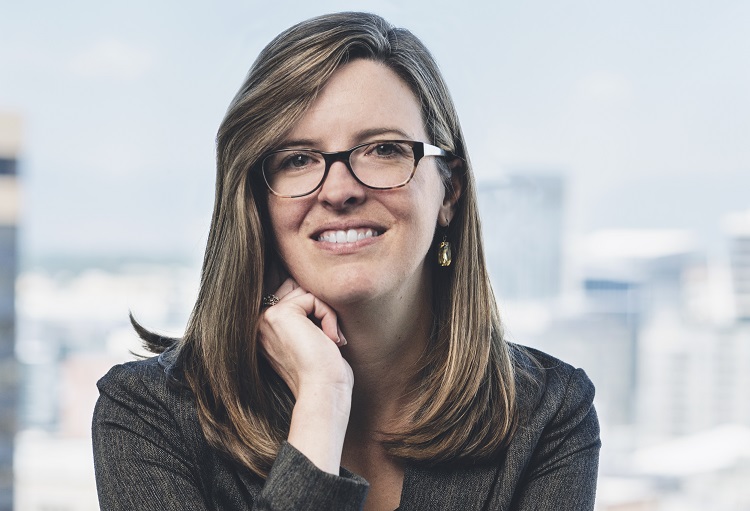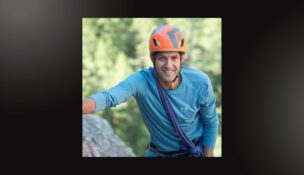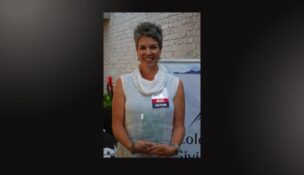Alice Jackson Guides Colorado Toward a New Energy Future
Alice Jackson, the president of Xcel Energy-Colorado is driving the company in a new direction
Lisa Ryckman //September 20, 2019//


Alice Jackson Guides Colorado Toward a New Energy Future
Alice Jackson, the president of Xcel Energy-Colorado is driving the company in a new direction
Lisa Ryckman //September 20, 2019//
Alice Jackson, President, Xcel Energy-Colorado
Age: 40
What she’s reading: “The Righteous Mind: Why Good People Are Divided by Politics and Religion,” by Jonathan Haidt
Alice Jackson’s perfect day would begin with a long walk somewhere, followed by cleaning something (she likes order), followed by building something—a bed, a dresser, a table—that’s both useful and lasting.
Woodworking is a skill she learned from her geochemist dad while growing up in Texas in a family of self-described geeks. “The design aspect of it, then getting out there and putting it together, figuring out how to make it work, and then seeing it over and over and over again,” Jackson says, “it gives you a sense of self.”
Jackson has little time for woodworking these days because she’s busy building something at Xcel — a way forward that includes cutting carbon emissions 80% from 2005 levels by 2030 and achieving net-zero carbon by 2050. She didn’t chase the job with Xcel in 2011, when she became regional VP for Rates and Regulatory Affairs for Texas and New Mexico, she says. She took it because there was less travel, which made sense for the working mother of four boys.
Jackson moved to the same position in Colorado in 2013, then became vice president of Strategic Revenue Initiatives three years later, leading the company’s revenue growth strategy; she was named president in 2018. Along the way, she came to a realization about her work and its value.
“What I evolved to understand is, it’s not just a privilege — it’s a responsibility,” Jackson says. “Electricity is a life essential. It’s the underpinning of our economy. We have to have it in order to keep everything moving forward. It went from being just a job to, I want to retire from the utility industry, because I believe that it is a social good.”
ColoradoBiz: You worked for Enron and Occidental Petroleum. How does having worked for these big energy companies inform your work now?
Alice Jackson: I actually have fewer years inside the utility industry than I do outside the utility industry. I think one of the best things of about having spent a lot of time on that heavy electric-intensive consumer side, is that I have customer perspective. So when I sit at the table with our customers, particularly ones that are high-intensity electric users, I understand where coming from, I know what looking for from us as far as the reliability aspect, so how do we get to position where we’re both happy, how do we make sure we’re providing the best service possible, when we’re making decisions in our business about how to evolve, what is it they’re going to be thinking about and how are their bills going to be impacted by the decisions that we’re making? It kind of gives me that balance to be able to come at that decision-making from that customer perspective in addition to the utility’s perspective.
CB: Xcel recently announced that it will cut carbon emissions 80% (from 2005 levels) by 2030 and achieve net-zero carbon by 2050. What factors made that announcement possible?
AJ: First off, our customers and communities have been asking us to look at these spaces and how to move forward to achieve those carbon reductions in the quickest way possible. Across our state, various communities—the city of Denver, Breckenridge, Vail and others—are focusing on the renewable aspect of the system, figuring out how to make it the highest level of renewables they possibly can. When we sit down and look at it, it’s not just a combination of renewables, when you’re chasing renewables, you’re really chasing carbon. My first responsibility to the citizens of our state is to provide reliable electricity. My first responsibility to my employees is to do it in a safe manner. And then my next responsibility is to do it as economically as possible. So I take those things into account, so how does the sustainability aspect our communities have been asking us about for a little over decade now, how do we incorporate that into our equation? We got to make sure keep lights on. We’ve got to make sure it’s affordable, and we’ve got to make sure we’re incredibly safe for our employees. How do we weigh all that together and bring it into a form that makes sense?
We started doing that analysis. What does it look like to have that 100 percent renewable system? How does that work? We had others that were looking at the same thing. If you look to California, they’ve been exploring that for a while and figuring out, okay, how does this work? Does it work? And what they’re finding is that, you can get to 60 percent. You can get to maybe 70 percent renewables. But that last 30 percent is incredibly expensive and puts a real drain on the system from a reliability perspective. So we took a step back and said, what is it we’re really trying to chase? What are we trying to eliminate from the system? What is the driver? We came to the conclusion that carbon is what we are chasing. So it makes sense to look at not just renewables to solve the problem but any carbon zero or carbon neutral resource. We believe that’s going to bring down the cost to make it affordable to achieve those goals long-term. Getting to 80 percent carbon reduction, we can do with technology existing today. The existing technology between wind, solar, battery storage, pumped hydro, carbon capture, we can do that today. And we can get there economically. We still have a question, and we still have to work on additional technological developments to get to that zero carbon system. We’re betting on the fact that technology is going to continue to advance.
CB: How do you think that announcement might have changed people’s perception of Xcel?
AJ: I’ve been in this president’s role for a little over a year, and one of the things this brought home to me was how important this was to announce, not only for the company to figure out how to make the transition but how it impacted our community, was the number of emails I got from random people inside and outside Colorado saying, ‘How do I get a job to help you do this?’ Right? I said there and went, okay, this matters. Because we were the first utility to announce this, we are one of the most advanced when it comes to the amount of renewables we’ve integrated on our system, and what quite frankly still bothers me, is that most people don’t even realize that. And so that’s something else we’ve been trying to do, is have more communication inside of our communities to really share that message, so that people can understand and appreciate and also go, ‘You know what? This does make a difference, and I’m going to be really supportive moving this forward. The announcement is great, but those guardrails of trying to figure out how to solve this puzzle, to have reliability still maintained and in a cost-effective way, is incredibly important.
CB: Have you gotten push back from any quarters? Like utilities in other parts of the country?
AJ: We’ve gotten more support than any pushback, but every single state is a little bit different, our economics are different, the economy and and jobs underlying that state are different, but also the availability of access to resources. If you look at where Xcel operates, from the northern border of the U.S., Michigan, through Wisconsin, into Minnesota, North and South Dakota, Colorado, Texas and New Mexico, if you pulled up a map of where the wind is the best, you’re going to see across those eight states. If you look at where solar intensity is really good, you’ll see that in Colorado particularly as well, but also New Mexico and Texas. We have a unique opportunity to lead in how you put this together in a way that makes sense, because we can generate energy from those particular resources in a really cost-effective manner, which will help drive down the cost for the next people to do it. We know wind and solar aren’t going to be the only things we have on our system. We have a pumped hydro facility in Georgetown that’s been there since the 1950s. And that particular resource can help us balance the variability associated with wind. Those types of resources are necessary to do the integration portion, so those are going to be important factors in how do we achieve those goals and targets.
CB: What do you say to people who say, why are you bothering with this? Climate change isn’t a man-made problem and it’s not something you should be trying to fix. The naysayer part of this?
AJ: We do get those questions. First off, this is economic to undertake on behalf of our customers, and we think it’s going to continue to be economic going forward. You don’t buy a car expecting it to run for the rest of your life. You don’t buy a car expecting to drive it for 30 or 40 years. We have to build generations units, the wind farms you see, they also don’t last forever, so we have to replace them. As new technology develops, you’re driving a Gremlin any more, right? That’s the same kind of thing you’re seeing with the technology evolution. Let’s look at this and see, what’s the most cost-effective way for us to deliver what you need to light your home, you’re your business, manufacture your products. Set climate change aside. It’s more cost-effective today. Let’s make sure we’re making smart, economic decisions for our customers not only near-term, but long-term. The second piece of this is I sit back and reflect on something Ronald Reagan did. Do you remember the ozone conversation, with CFCs and aerosols, there was a big debate on whether the science was correct, and should we take action or not? And ultimately, what Ronald Reagan came out and said was, think of it as an insurance policy. If the science is wrong but we can find a solution that doesn’t break the bank that fixed the problem we think may be there, what’s (wrong) with doing that? But if science is right, and we don’t do anything, the results could be catastrophic. So we try to depoliticize this and say, let’s make smart decisions about the economics.
CB: Utilities and energy sectors seem to have been traditionally male-dominated. What has it been like to be one of the first through the wall?
AJ: There was a Wall Street Journal article talking about women executives in the C-suite, and of the S&P 500 companies, utilities had actually the highest percentage of women in the C-suite. Which was surprising to me. We are still few and far between, but we are making good progress in being able to be represented, and I think a lot of that comes down to prior generations and the conversations that have been happening around that diversity of thought, and what does it bring to the table. There’s definitely a different perspective. I have come to this realization: Utilities are an odd animal. Instead of competing for customers, we have an area on a map that’s drawn out, and you will serve every last person in this space. You will serve every business, every person who wants to light their rock. What I evolved to understand is, it’s not just a privilege — it’s a responsibility. When I sit back and look at the social aspects of other jobs, caseworkers, others admirable positions, there’s not another job I could work, not another social cause I could work in that would touch more lives than the one I’m working in right now. Electricity is a life essential. It’s the underpinning of our economy. We have to have it in order to keep everything moving forward. It went from being just a job to, I want to retire from the utility industry, because I believe that it is a social good, that as long as I do a good job, I’ll not only do a good job for my customers, but my shareholders. It’s been this evolution of connection to what we do that has changed for me the purpose of the job that I have.
CB: What’s most important to you as a leader?
AJ: Respect. That’s my No. 1, is respect for everyone. You’re not going to agree with everyone. I’ve had people who don’t agree with what we’re looking at doing. There’s a lot of emotion associated with that, rather than just being logic. My philosophy is there has to be respect for everyone whether agree with them or not, even if they are being less than kind, that doesn’t mean you have leave to be less than kind to them. That’s foundational for me, whether I’m working with employees, in working with peers, meeting with my stakeholders, community representatives, it is foundational to the way we have to lead. Second, when you’re hiring a person, what is their love associated with the job they’re doing? How do you develop them and invest in them to make them the best they can be in their job. The philosophy I’ve adopted is, hire your boss. Make sure you hire people who one day have the potential be your boss. And if you’re doing that, you’re going to be getting really good people and have privilege of working for them someday.
CB: What kinds of partnerships is Xcel undertaking?
AJ: My primary focus is going to be around technological advancements we’re seeing. We partner very closely with our communities. We have something called “Energy Future Collaboration,” We sit down with our various communities and put together a Memorandum of Understanding that says, here’s the space city operates that overlaps with energy, here’s where Xcel overlaps with the energy piece, here are the priorities city wants to solve. Some of our communities want electric vehicle charging stations, others say, we’ve said we want to be 100 percent renewable, what’s the path to get there? Others are looking at energy efficiency. So whatever is on their list, we try to find space to sit down and collaborate with them.
CB: What’s the biggest challenge Xcel faces right now?
AJ: My team will tell you I usually refer to them as opportunities, because it’s something we haven’t solved yet. I’ll put it this way. I think the biggest challenge we have right now is the space to make the progress need to without picking winners or losers ahead of time. The solution for the problem statement we’ve put out there is somewhat unknown. We have definitely interest groups most interested in bringing forth their solution as, this is THE one. We need time and we need space for technology to evolve before we pick winners or losers, whether it’s through legislation, city ordinance, county preferences. Let’s make sure we’re doing the carbon reduction a lot of us want in the best way possible for the lowest cost. We need the time and space. One of the biggest challenges I have now is that people are so anxious to have it done now, to know what the answer is, that we don’t get that space to solve the puzzle in the most reasonable manner.
























